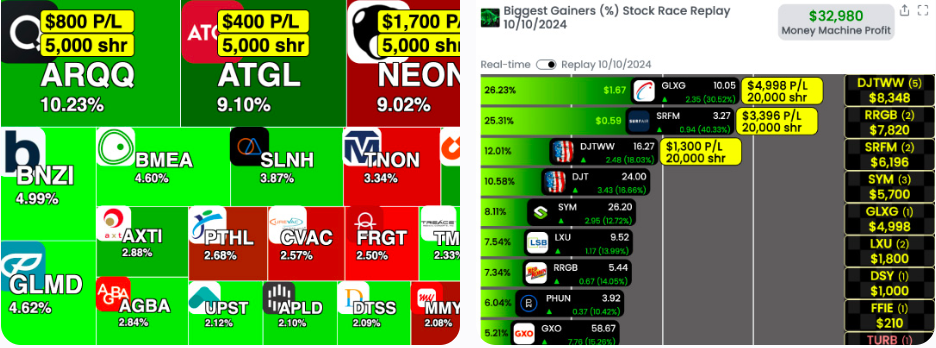20 Best Ideas For Selecting AI Stock Trading Platform Sites
20 Best Ideas For Selecting AI Stock Trading Platform Sites
Blog Article
Top 10 Tips To Evaluate The Strategy Customization Of Ai Stock Forecasting/Analyzing Trading Platforms
AI platform for stock-predicting and analyzing stocks offer numerous options for customization that let users adapt their platform to their individual trading goals in terms of risk-taking, as well as market conditions. A platform offering a range of customizations can enhance your trading. Here are the best 10 ways to evaluate the ability of platforms to tailor their strategies:
1. Evaluate Pre-Built Strategy Templates
A variety of templates to choose from - Check to see if there's built-in strategies that are designed to accommodate different styles of trading.
The user's experience is a good indication.
Performance history: Determine whether the platform offers historical performance information for the pre-built strategies.
2. Create a Custom Strategy
Drag-and-drop tools: Choose platforms that have drag-and-drop interfaces that allow you to easily create personalized strategies.
Coding options: For advanced users make sure the platform supports custom programming in proprietary scripting language (e.g. Python, R).
Flexibility: Ensure the platform lets you define your entry and exit parameters as well as risk management metrics and other important components of your strategy.
3. Check for Backtesting Capabilities
Historical data: Determine whether your platform provides enough historical data to test strategies for backtesting.
Customizable parameters: Ensure you can adjust parameters (e.g. timespans, timeframes or indicators) during backtesting.
Performance metrics: Make sure the platform offers detailed measures of performance (e.g. Win rate Sharpe Ratio) when backtesting strategies.
4. Evaluate Real-Time Strategy Testing
Paper trading: Make sure the platform allows you to practice or test your strategies without risking any capital.
Live testing: Determine whether you can test your strategies on real markets using small amounts capital.
Real-time adjustments: Determine whether strategies can be modified according to market conditions.
5. Integrate integration with technical indicators
Indicator library - Check whether the platform has an extensive library of technical indicators, like moving averages (e.g. RSI), MACD, or RSI.
Custom indicators. Ensure that you have the ability to design or implement custom indicators in your strategy.
Verify that the platform allows you to combine multiple indicators to create complex strategies.
6. Check for Risk Management Tools
Stop-loss/take-profit: Ensure the platform allows you to set stop-loss and take-profit levels within your strategies.
Position sizing: Check if you can define position sizing rules (e.g. fixed amount, percentage of portfolio) to reduce the risk.
Risk-reward-ratio: Check the platform's capabilities to set the risk/reward ratios of individual trades or trading strategies.
7. Evaluate Multi-Asset Strategy Support
Asset classes: Make sure that the platform can help strategies across multiple asset categories (e.g. ETFs, stocks or options or forex).
Strategies that cross assets: You could make strategies that involve various asset types (e.g. pairs trading hedges, pair trading).
Market coverage. Check if the platform covers the markets that you are looking to invest in (e.g. US international, cryptocurrencies).
8. Evaluate the automation and Execution
Automated trading - Ensure that the platform is capable of automating trading strategies based on the established rules.
Order types - Check that the platform can support a variety of order types that can be used to execute strategies (e.g. stop market, limit or stop).
Latency: Make sure that the platform is running at minimum latency for trading, especially if employ high-frequency strategies.
9. Make sure you are using tools to optimize your strategy
Optimization of parameters - Make sure that the platform includes tools to optimize your strategy's parameters.
Machine learning integration: Determine whether the platform is using machine learning for refinement or improvement of strategies.
Scenario analysis: Determine that the platform is able to test strategies for different market scenarios (e.g., bear, bull and volatile).
10. Review Community Support and Feedback from Users
User feedback Conduct research on users to evaluate the effectiveness of the platform's the development of a customized strategies.
Forums for community members: See whether you can find a forum where users discuss and share custom strategies.
Support resources - Make sure that the platform provides guides and instructions for users to develop and improve strategies.
Bonus Tips
Trial period for free: You are able to explore the options for customization of the platform with a a demo or free trial.
Scalability: Ensure the platform you choose to use can handle complex strategies that evolve when you trade.
Customer Support: Ensure that the platform has assistance for any concerns related to strategy or questions.
Follow these tips to assess the AI stock predicting/analyzing platforms' capability to modify strategies. If you do this you can be sure that you choose a platform that matches your needs for trading and allows you develop and improve your personal strategies. A platform that offers powerful customization options will allow you to adjust to changes in market conditions and boost your results. Read the recommended find about best ai stock trading bot free for website examples including ai stocks, chatgpt copyright, ai stock trading bot free, best ai trading app, trading ai, best ai for trading, ai chart analysis, ai trade, ai for stock trading, ai for investing and more.
Top 10 Tips For Evaluating Transparency Of Ai-Based Platforms For Trading Stocks
Transparency is a factor to consider when evaluating AI platforms for stock trading and prediction. Transparency ensures users can trust platform operations, understand decisions, and verify reliability of forecasts. Here are ten tips on how to evaluate the authenticity of platforms.
1. Clear Explanation of AI Models
Tip - Check that the platform provides a thorough explanation of the AI algorithms that are used to predict the future.
Why: By understanding the technology, users are able to determine its reliability and limitations.
2. Disclosure of Data Sources
Tip: Make sure the platform reveals the sources of data it draws from.
What is the benefit of knowing the sources of information You can be sure that the platform uses trustworthy and accurate information.
3. Performance Metrics and Backtesting Results
Tips Look for reports that are transparent of performance metrics.
The reason: It lets users verify the effectiveness of the platform and its historical performance.
4. Updates and notifications in real-time
Tips: Make sure you are receiving real-time alerts and updates about trades, predictions or changes to the system.
What is the reason? Real-time transparency allows users to be updated on every critical action.
5. Transparent Communication Concerning Limitations
Tip: Check if the platform openly discusses the risks and limitations of its trading strategies.
What's the reason? Recognizing the limitations of a product can build trust, which helps users make more informed decisions.
6. Access for users to raw Data
Tip : Determine if you are able to access raw data and intermediate results that are used by AI models.
Why: Raw data access allows users to do their own analysis and verify the results of their own predictions.
7. Transparency regarding fees and charges
TIP: Ensure that the website clearly lists the costs for subscriptions, fees, and potential hidden charges.
Why: Transparent pricing prevents unexpected costs and builds trust.
8. Regularly scheduled report and audits
Verify if a platform has regular reports and undergoes third party audits in order to verify the performance of its operations.
Independent verification is crucial as it increases the credibility of the process and guarantees accountability.
9. Explanability of Predictions
TIP: Search for information about the process by which the platform creates forecasts or makes specific suggestions (e.g. the importance of features and decision trees).
Why Explainability is a tool that aids users in understanding AI-driven decision-making.
10. Customer Feedback and User Support Channels
Tips. Check if there are channels available for user feedback, support and transparency in response to concerns of users.
Why is that responsive communication demonstrates an interest in the transparency of users and their satisfaction.
Bonus Tip – Regulatory Compliance
Make sure that the platform is compliant with all applicable financial regulations. This adds an additional layer of transparency.
You can make informed decisions by taking a look at all these aspects. Take a look at the recommended how to use ai for stock trading for blog examples including ai software stocks, ai share trading, ai stock predictions, best ai stocks to buy now, stock predictor, can ai predict stock market, ai stock prediction, stocks ai, chart analysis ai, trading ai tool and more.